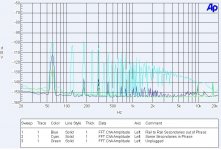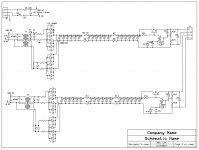Do these caps have lower noise than a good battery?
That is one of the things I will be measuring. A bit back I showed that circuit, I think.
Pop? The preamp can run for 1/2 hour per charge and recharge is easily ramped.
Do these caps have lower noise than a good battery?
Panasonic lists 30 Ohms ESR so that would be 120 Ohms or 1.4nV the NIST study found several batteries far quieter. Maybe the huge ones used for car stereo bypassing might work better. Back of the envelope you need .25 Ohms per cell to reach the very best battery.
Last edited:
Panasonic lists 30 Ohms ESR so that would be 120 Ohms or 1.4nV the NIST study found several batteries far quieter. Maybe the huge ones used for car stereo bypassing might work better. Back of the envelope you need .25 Ohms per cell to reach the very best battery.
AVX lists .035 ohms for their flat package style versions!
http://www.avx.com/docs/Catalogs/bestcap.pdf
Their are a few others below .25 ohms.
The newer high current versions are made for motor run by battery use. The idea is peak currents discharge batteries faster so the supercaps provide the initial higher current and the batteries the rest.
But I did err, the recharge cycle looks more like once a minute.
Last edited:
LIO Technology for the Audiophile seem to have got there first, but they use 2 banks and charge one whilst the other is 'active'. But great minds etc 
LIO Technology for the Audiophile seem to have got there first, but they use 2 banks and charge one whilst the other is 'active'. But great minds etc
The "no" AC to DC conversion escapes me if it's mains powered at the beginning. Seems great for a pre-amp, I wonder what the bank switching time is at full power for a PA.
The "no" AC to DC conversion escapes me if it's mains powered at the beginning. Seems great for a pre-amp, I wonder what the bank switching time is at full power for a PA.
Appears to be an external power supply. A 10 farad bank at 40 volts might actually work for a 50 watt per channel amplifier as the average output should be 1/2 watt. But for practical purposes the output stage could be conventionally powered.
Panasonic lists 30 Ohms ESR so that would be 120 Ohms or 1.4nV the NIST study found several batteries far quieter. Maybe the huge ones used for car stereo bypassing might work better. Back of the envelope you need .25 Ohms per cell to reach the very best battery.
That is what I thought, I bought some dubillier (?) double layers to play with a little while ago and I found them to be quite high esr.
The "no" AC to DC conversion escapes me if it's mains powered at the beginning.
I think they call that 'marketing'.
The ideally-floating supply for the proposed I source that achieves a small improvement in the complementary folded cascode preamp can be balanced so that a bog-standard dual bobbin transformer's line noise injection is small. Of course additional common-mode chokes don't hurt.
The big cap banks could be switched smoothly enough to avoid audible transients---but I could imagine a scheme like that inducing paranoia---did I just hear that?
The big cap banks could be switched smoothly enough to avoid audible transients---but I could imagine a scheme like that inducing paranoia---did I just hear that?
Simon, the problem with AC is, on my point of view, not so much noise on the rails (it is easy to design high PSRR devices), but leakeage induced by the transfo creating parasitic noise between the ground of several devices connected together.
So, traditional batteries that recharge when you don't listen to music and disconnect from AC when music is playing seems to me the best solution.
So, traditional batteries that recharge when you don't listen to music and disconnect from AC when music is playing seems to me the best solution.
That is what I thought, I bought some dubillier (?) double layers to play with a little while ago and I found them to be quite high esr.
A lot of the original use was for memory keep alive circuits. Very low current requirements. But folks like Eaton who make batteries are getting into the market with ones designed for high surge currents. These are the type to look at for low noise. Some are quite reasonably priced.
Here is one http://www.mouser.com/ds/2/257/Maxwell_16V Small Cell Module_DS_1015371-6-341171.pdf
Cost is $122 ea onsies. It could tun a small preamp for hours dropping from 16 volts to 12 volts at 20 mA.
I started looking at these as replacements for hand power tool batteries. Run time is shorter, maximum torque a bit better and recharge time way shorter. Weight is also less. Best of all they last much longer. In my shop we are getting batteries re-celled about every two years.
So having some on hand and building what should be an almost adequate noise meter, seems worth a try.
ES
Simon, the problem with AC is, on my point of view, not so much noise on the rails (it is easy to design high PSRR devices), but leakeage induced by the transfo creating parasitic noise between the ground of several devices connected together.
So, traditional batteries that recharge when you don't listen to music and disconnect from AC when music is playing seems to me the best solution.
That can be an issue. Around here you can flip power cord plugs around to minimize some of that. Batteries just don't last as long as these capacitors for shelf life. There is also the issue of bubble noise on lead acid batteries.
In a conventional linear power supply the line noise is conducted during the rectifier diodes on period. Some folks bypass the rectifiers with capacitors that then pass the line noise all the time. A properly sized capacitor will reduce switching spikes from rectifier types that produce them and minimize the line noise. Most designs I have seen that use bypass capacitors size them way too large.
But there really is more than one way to skin a cat. Especially these days with food processors!
Yes, while they reduce switching ringings, they allowed the HF to pass in the rails all the time.Some folks bypass the rectifiers with capacitors that then pass the line noise all the time.
Last edited:
Bypassing is a mixed blessing, true. By itself it just tends to lower the resonant frequency of the reverse-recovery spikes to where the local loops don't radiate as well, and that's useful to an extent.Yes, while they reduce switching ringings, they allowed the HF to pass in the rails all the time.
If one goes back many many posts, John Curl showed some power supply details which indicate some other means of suppressing line noise.
Bypassing is a mixed blessing, true. By itself it just tends to lower the resonant frequency of the reverse-recovery spikes to where the local loops don't radiate as well, and that's useful to an extent.
If one goes back many many posts, John Curl showed some power supply details which indicate some other means of suppressing line noise.
When testing for CE approval that is what I found it just shifts it around a bit on the spectrum analyzer in some case it was worse. One cap across the bridge input with HS diodes worked best. Well best to past the conducted emission to the line at least.
- Status
- Not open for further replies.
- Home
- Member Areas
- The Lounge
- John Curl's Blowtorch preamplifier part II

